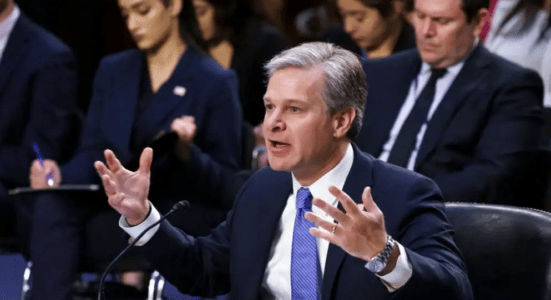
FBI: Al-Qaeda determined to strike at US despite leader’s killing
FBI Director Christopher Wray said on Thursday that he remains worried about the potential for a large-scale attack planned or inspired by al-Qaida despite the killing of its top leader in a U.S. drone strike in Afghanistan last weekend.
Both al-Qaida and the Islamic State as well as their affiliates “intend to carry out or inspire large-scale attacks in the United States,” Wray said during testimony before the Senate Judiciary Committee.
Al-Qaida chief Ayman al-Zawahiri, a key architect of the attacks of September 11, 2001, was killed during the early Sunday morning strike on a safehouse in central Kabul.
Asked if al-Qaida or the Islamic State would strike at the United States if given the opportunity, Wray said, “Oh, yeah!”
In the near term, however, al-Qaida, with its leadership degraded, is more likely to focus on “cultivating its international affiliates and supporting small-scale” attacks in regions such as East and West Africa, he said.
In his first public remarks about al-Zawahiri’s killing, Wray said he was “not surprised but disappointed” that the head of al-Qaida was found hiding in a safehouse allegedly owned by a senior member of the Haqqani Network.
Al-Zawahiri, who took over as al-Qaida leader after Osama bin Laden was killed in a U.S. raid in 2011, was on the FBI’s Most Wanted List with a $25 million reward for his capture.
After the strike, the Biden administration accused the Taliban of violating a 2020 agreement under which the group pledged not to allow any terrorist groups to use Afghan soil to threaten the United States or its allies.
Taliban officials said they were unaware of al-Zawahiri’s residence in Kabul.
Asked by Republican Senator Lindsey Graham whether al-Zawahiri’s presence in the Haqqani safehouse suggested the Taliban and al-Qaida continued to enjoy a close relationship, Wray tersely responded: “Nothing good.”
The “over-the-horizon” strike against al-Zawahiri has augmented the view held by some experts and Biden administration officials that the United States can continue to carry out such counterterrorism operations in Afghanistan without maintaining a presence on the ground.
Still, Wray said he’s worried about the “potential loss of and collection [of intelligence]” in the wake of the U.S. withdrawal in Afghanistan.
“So, we’re going to have growing intelligence gaps,” he said.
“And I’m worried about the possibility that we’ll see al-Qaida reconstruct, ISIS-K taking potential advantage of the deteriorating security environment, and I’m worried about terrorists, including here in the United States, being inspired by what they see over there,” he said. ISIS-K refers to Afghanistan’s Islamic State affiliate, Islamic State Khorasan.
Providing an assessment of national security threats facing the United States, he said the potential dangers have never been “greater or more diverse.”
The greatest threat emanates from “lone actors or small cells” who tend to radicalize online and attack soft targets, he said.
The FBI divides the domestic threats into two buckets: domestic violent extremists such as violent white supremacists and homegrown violent extremists such as ISIS-inspired jihadis.
Wray confirmed that the FBI is investigating a number of Afghan refugees who were airlifted to the United States last year despite security concerns.
The refugees were part of the more than 80,000 Afghan evacuees moved to the United States following the Taliban takeover last August.
In a report in February, the Defense Department’s inspector general faulted the National Counter-Terrorism Center for not fully vetting the evacuees, allowing at least 50 Afghans with “potentially significant security concerns” to enter the country.
Republican Senator Josh Hawley said a whistleblower recently came forward to claim that as many as 324 Afghans had been admitted into the United States despite appearing on a Defense Department watchlist.
“This is a watchlist that identifies folks whose biometrics have been collected and determined to be threats or potential threats to national security, including known suspected terrorists,” Hawley said.
Asked if the Defense or Homeland Security departments had communicated the new figure to the FBI, Wray said he did not know the exact number.
“I know there are a number of individuals through our joint terrorism task force that we’re actively trying to investigate as a result of” the inspector general report, he said.
Wray said the FBI has “a lot of information about where people are located,” but he could not tell whether the FBI knew their whereabouts “at any given time.”
Source: VOA News





